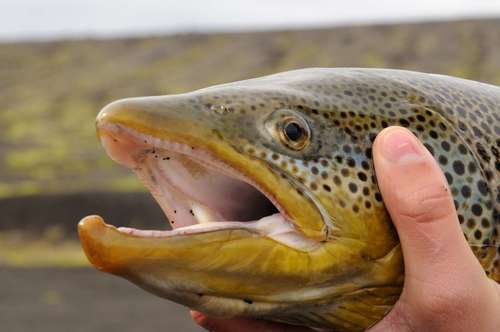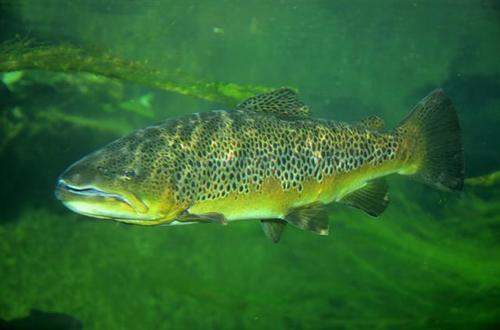Brown Trout
Salmo truttaSummary 7
The brown trout (Salmo trutta) is a European species of salmonid fish that has been widely introduced into suitable environments globally. It includes both purely freshwater populations, referred to Salmo trutta morpha fario and S. trutta morpha lacustris, and anadromous forms known as the sea trout, S. trutta morpha trutta. The latter migrates to the oceans for much of its life and returns to fresh water only to spawn. Sea trout in the UK and Ireland...
Taxon biology 8
Salmo trutta is a common trout known by two different common names reflecting the alternative ecological strategies and associated morphological characteristics of this species. The freshwater morphs (Salmo trutta morpha fario and S. trutta morpha lacustris) are known as brown trout. Sea trout is the anadromous morph which migrates between the ocean, where it spends most of its life, and freshwater spawning grounds. The two morphs, which often share the same breeding grounds (sympatric distribution), have in the past been classified as distinct species. The morphs do interbreed, but the extent of reproductive isolation between them varies by location and some studies have found genetic differentiation between morphs inhabiting the same territory.
Although native to Europe, northern Africa and western Asia, S. trutta has been widely introduced for aquaculture and recreational fishing purposes and is found in streams, lakes, and coastal areas throughout the world. Brown trout commonly mature at 13-16 inches long (often longer in large streams); sea-run morphs are larger and can be found up to 30 pounds and 3 feet long. An aggressive species, S. trutta has been responsible for declines in native fish populations, for example in the Great Lakes, where they displaced Arctic greyling (Thymallus arcticus) and in California, where they threaten native golden trout Oncorhynchus mykiss aguabonita and Dolly Varden (Salvelinus malma). This species was nominated as one of the world’s 100 worst invasive species by the Invasive Species Specialist Group (ISSG).
(CABI 2010;Charles et al 2005; Fuller, Larson and Fusaro 2012; Global Invasive Species Database, Invasive Species Specialist Group; Idema 1999; Wikipedia 2012)
Sources and Credits
- (c) Jesús Rodríguez Fernández, some rights reserved (CC BY-NC-ND), http://www.flickr.com/photos/jesusisland/8098363122/
- (c) anonymous, some rights reserved (CC BY-NC), http://www.biopix.com/photos/JCS-Salmo-trutta-lacustris-65459.JPG
- (c) Biopix, some rights reserved (CC BY-NC), http://www.biopix.com/PhotosMedium/Salmo%20trutta%20trutta%2000013.JPG
- (c) Biopix, some rights reserved (CC BY-NC), http://www.biopix.com/photos/JCS-Salmo-trutta-lacustris-65458.JPG
- (c) anonymous, some rights reserved (CC BY-NC), http://www.biopix.com/photos/JCS-Salmo-trutta-trutta-65460.JPG
- (c) anonymous, some rights reserved (CC BY-NC), http://www.biopix.com/photos/JCS-Salmo-trutta-lacustris-65455.JPG
- (c) Wikipedia, some rights reserved (CC BY-SA), http://en.wikipedia.org/wiki/Salmo_trutta
- (c) Unknown, some rights reserved (CC BY-NC), http://eol.org/data_objects/16122145
More Info
- iNat taxon page
- Animal Diversity Web
- Atlas of Living Australia
- Biodiversity Heritage Library
- BOLD Systems BIN search
- CalPhotos
- FishBase
- FishSource
- Global Biodiversity Information Facility (GBIF)
- Maryland Biodiversity Project
- NatureServe Explorer 2.0
- NBN Atlas
- VertNet
- World Register of Marine Species
- 日本のレッドデータ検索システム











